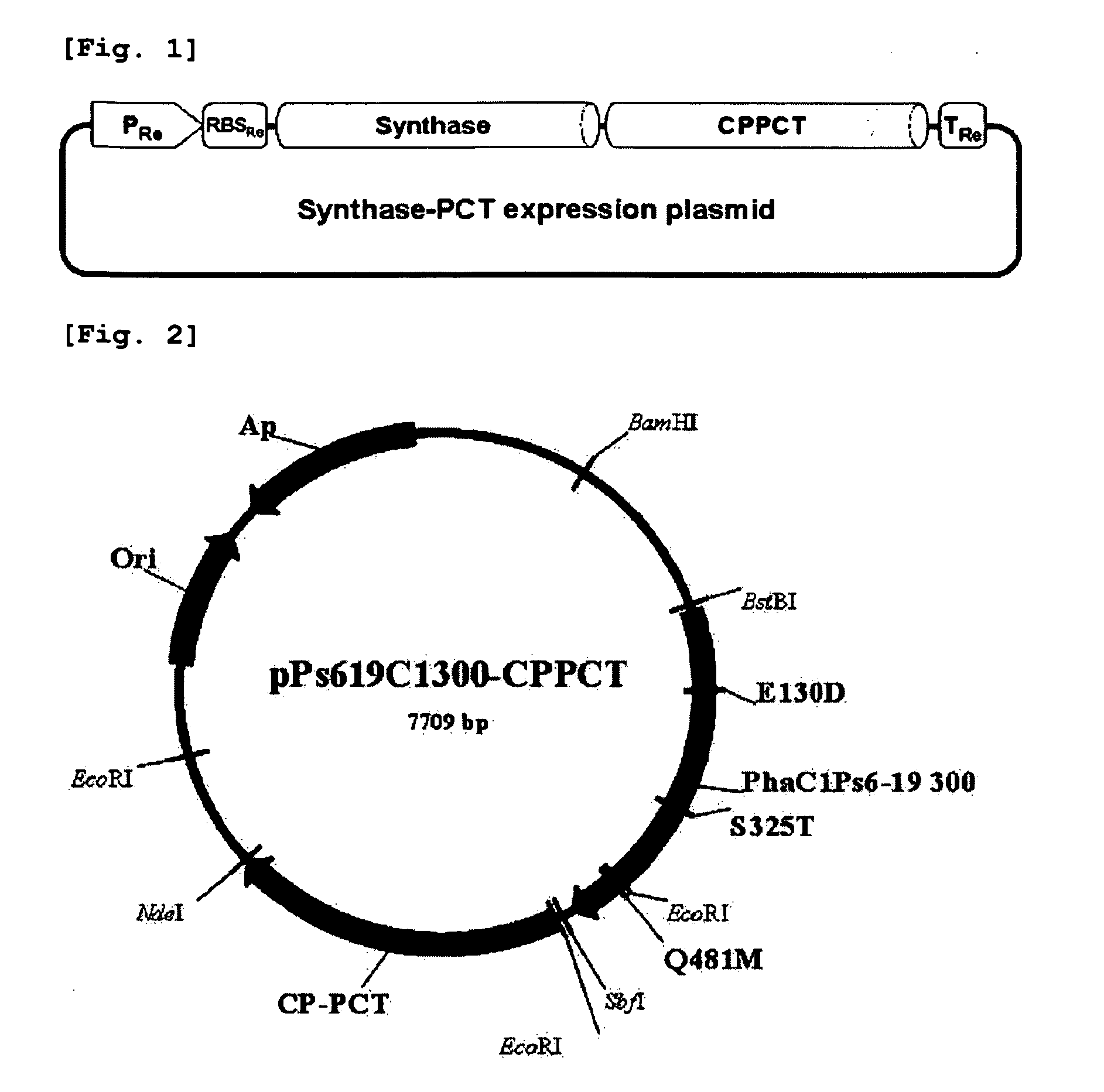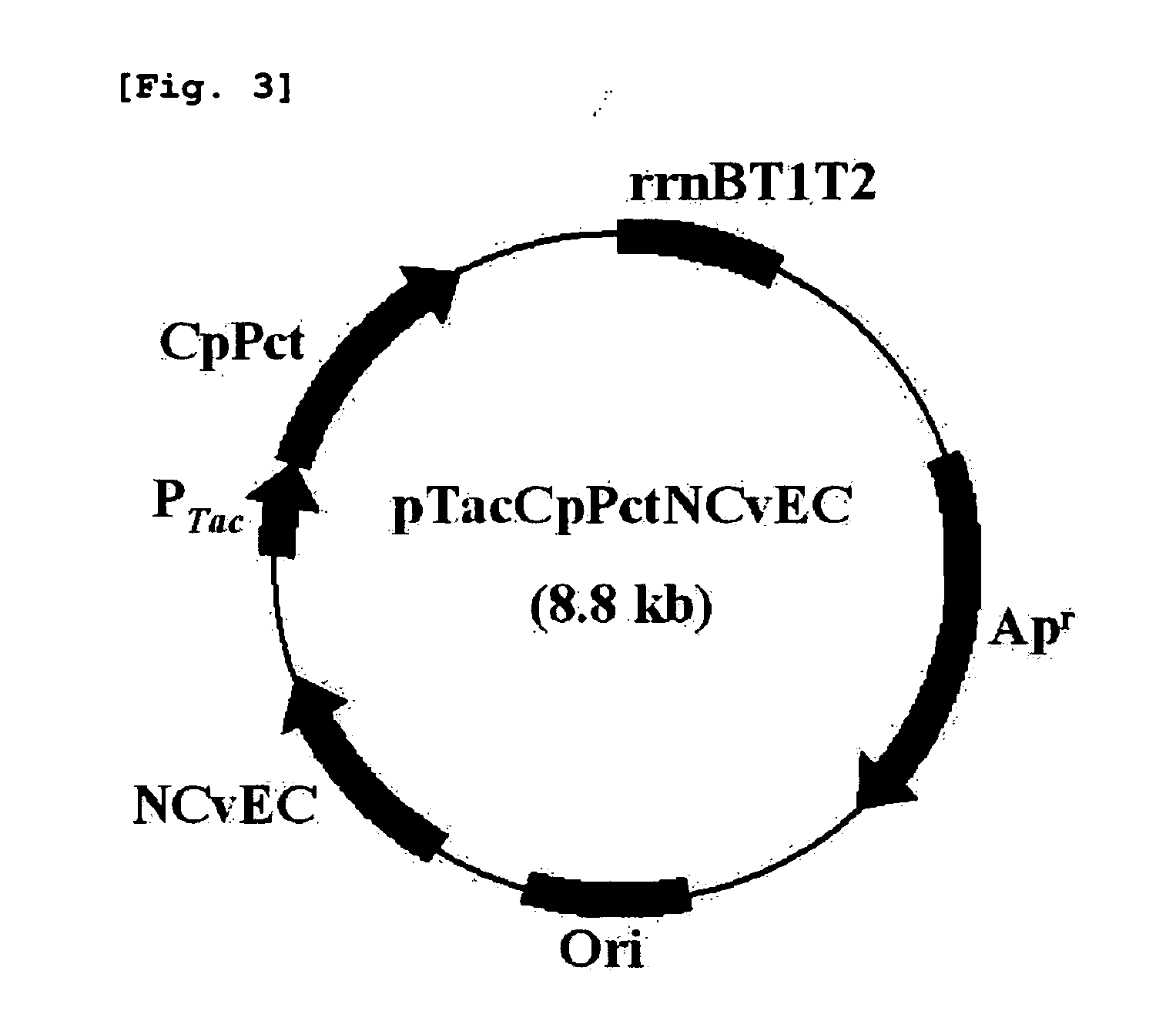Copolymer comprising 4-hydroxybutyrate unit and lactate unit and its manufacturing method
a technology of hydroxybutyrate and polymer, which is applied in the direction of biocide, enzymology, genetic material ingredients, etc., can solve the problems of complex process for preparing pla of high molecular weight, easy to be removed, and no examples of natural production or production by recombinant cells
- Summary
- Abstract
- Description
- Claims
- Application Information
AI Technical Summary
Benefits of technology
Problems solved by technology
Method used
Image
Examples
example 1
Construction of a Recombinant Plasmid Comprising PCT Gene and PHA Synthase Gene
[0038]Recombinant plasmids, pPs619C1300-CPPCT and pTacCpPctNCvEC, comprising pct gene and PHA synthase gene are constructed to prepare a copolymer comprising 4-hydroxybutyrate unit and lactate unit.
[0039](1) Construction of Plasmid pPs619C1300-CPPCT
[0040]Propionyl-CoA transferase (CP-PCT) gene derived from Clostridium propionicum was used as the pct gene, and PHA synthase gene derived from Pseudomonas sp. 6-19 was used as the PHA synthase gene.
[0041]The operon of constitutive expression system expressing PHA synthase and CP-PCT together was constructed like FIG. 1. CP-PCT was well known to have toxicity to host microorganism. That is, in tac promoter or T7 promoter expression system induced by IPTG (this system is widely used in expression of a recombinant protein), all microorganisms become dead shortly after the addition of inducer. Because of this reason, it is thought as suitable to use expression sys...
example 2
Preparation of 4-hydroxybutyrate-lactate copolymer
[0054]E. coli Top 10 (Invitrogen) was transformed with the pPs619C1300-CPPCT obtained in example 1 and pMCSPtbBuk together to get E. coli Top10 / pPs619C1300-CPPCT / pMCSPtbBuk.
[0055]The transformant was cultured by two steps to get 4-hydroxybutyrate-lactate copolymer as follows: First, the transformed recombinant E. coli Top10 / pPs619C1300-CPPCT / pMCSPtbBuk was cultured for 24 hours in 100 mL of LB medium (Bacto™ Triptone(BD) 10 g / L, Bacto™ yeast extract(BD) 5 g / L; NaCl (amresco) 10 g / L) containing 100 mg / L of ampicillin and 30 mg / L of chloramphenicol, and then the medium was centrifuged for 15 minutes at 4° C., 1000 g to collect cells.
[0056]Collected cells was anaerobically cultured for 3 days in MR medium (Glucose 10 g, KH2PO4 6.67 g, (NH4)2HPO4 4 g, MgSO4.7H2O 0.8 g, citric acid 0.8 g and trace metal solution 5 mL per 1 L; Trace metal solution composition: 5M HCl 5 mL, FeSO4.7H2O 10 g, CaCl2 2 g, ZnSO4.7H2O 2.2 g, MnSO4.4H2O 0.5 g, CuS...
example 3
Preparation of 4-hydroxybutyrate-3-hydroxypropionate-lactate terpolymer
[0059]4-Hydroxybutyrate-3-hydroxypropionate-lactate terpolymer was prepared according to the method of example 2 except that the collected cells was anaerobically cultured for 3 days in MR medium further containing 2 g / L of 4-hydroxybutyrate (4-HB), 2 g / L of 3-hydroxypropionate (3-HP), 100 mg / L of ampicillin and 30 mg / L of chloramphenicol instead of MR medium further containing g / L of 4-HB, 100 mg / L of ampicillin and 30 mg / L of chloramphenicol.
[0060]As a result of the analysis, methyl-4-hydroxybutyrate, methyl-3-hydroxypropionate and methyl-lactate were detected in E. coli Top10 / pPs619C1300-CPPCT / pMCSPtbBuk transformant, which meant that new 4-hydroxybutyrate-3-hydroxypropionate-lactate terpolymer [poly(4-hydroxybutyrate-co-3-hydroxypropionate-co-lactate)] was prepared by the recombinant E. Coli. 1H-NMR and GC-MSD results of the obtained 4-hydroxybutyrate-3-hydroxypropionate-lactate terpolymer were shown in FIGS....
PUM
| Property | Measurement | Unit |
|---|---|---|
| molecular weight | aaaaa | aaaaa |
| molecular weight | aaaaa | aaaaa |
| molecular weight | aaaaa | aaaaa |
Abstract
Description
Claims
Application Information
 Login to View More
Login to View More - R&D
- Intellectual Property
- Life Sciences
- Materials
- Tech Scout
- Unparalleled Data Quality
- Higher Quality Content
- 60% Fewer Hallucinations
Browse by: Latest US Patents, China's latest patents, Technical Efficacy Thesaurus, Application Domain, Technology Topic, Popular Technical Reports.
© 2025 PatSnap. All rights reserved.Legal|Privacy policy|Modern Slavery Act Transparency Statement|Sitemap|About US| Contact US: help@patsnap.com



